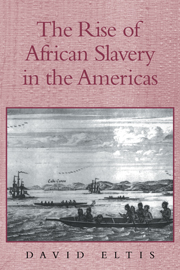Book contents
- Frontmatter
- Contents
- List of Tables
- List of Maps
- Preface
- Abbreviations
- Chapter 1 Slavery and Freedom in the Early Modern World
- Chapter 2 The English, the Dutch, and Transoceanic Migration
- Chapter 3 Europeans and African Slavery in the Americas
- Chapter 4 Gender and Slavery in the Early Modern Atlantic World
- Chapter 5 Productivity in the Slave Trade
- Chapter 6 Africa and Europe in the Early Modern Era
- Chapter 7 The African Impact on the Transatlantic Slave Trade
- Chapter 8 The English Plantation Americas in Comparative Perspective
- Chapter 9 Ethnicity in the Early Modern Atlantic World
- Chapter 10 Europe and the Atlantic Slave Systems
- Epilogue on Abolition
- Appendices
- Maps
- Sources and Bibliography
- Index
Chapter 4 - Gender and Slavery in the Early Modern Atlantic World
Published online by Cambridge University Press: 05 August 2012
- Frontmatter
- Contents
- List of Tables
- List of Maps
- Preface
- Abbreviations
- Chapter 1 Slavery and Freedom in the Early Modern World
- Chapter 2 The English, the Dutch, and Transoceanic Migration
- Chapter 3 Europeans and African Slavery in the Americas
- Chapter 4 Gender and Slavery in the Early Modern Atlantic World
- Chapter 5 Productivity in the Slave Trade
- Chapter 6 Africa and Europe in the Early Modern Era
- Chapter 7 The African Impact on the Transatlantic Slave Trade
- Chapter 8 The English Plantation Americas in Comparative Perspective
- Chapter 9 Ethnicity in the Early Modern Atlantic World
- Chapter 10 Europe and the Atlantic Slave Systems
- Epilogue on Abolition
- Appendices
- Maps
- Sources and Bibliography
- Index
Summary
If differences between European and African concepts of insider made a transatlantic slave trade from Africa possible, then differences in European and African constructions of gender helped determine which Africans entered that trade. As Edmund Morgan argued a quarter-century ago, Europeans put African women to work in whip-driven field gangs in the Americas but were not prepared to see European women work under like conditions, a kind of sexual theory of slavery. As this suggests, Europeans and Africans defined gender as they defined the line dividing insider from outsider – with no apparent reference in either case to maximizing efficiency on plantations in the Americas or, more narrowly, what was in their best pecuniary interest. Once more, the profit-maximizing model of human behavior makes little sense unless it is placed within a cultural framework.
One route into early modern European constructions of gender is provided by the captain of the slave ship Hannibal, which sailed from London to the African coast in 1694. “This morning,” he wrote,
“we found out that one of the Royal African Company soldiers, for their castles in Guiney, was a woman, who had entered herself into their service under the name of John Brown, without the least suspicion, and had been three months on board without any mistrust, lying always among the other passengers. […]
- Type
- Chapter
- Information
- The Rise of African Slavery in the Americas , pp. 85 - 113Publisher: Cambridge University PressPrint publication year: 1999



